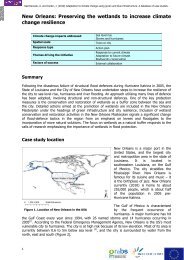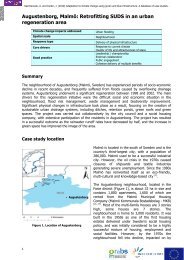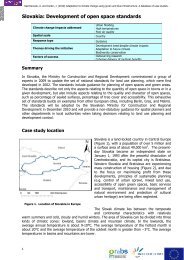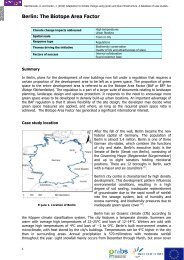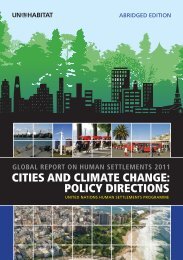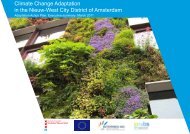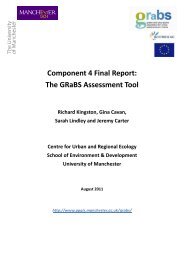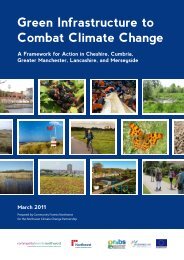Download - GRaBS
Download - GRaBS
Download - GRaBS
Create successful ePaper yourself
Turn your PDF publications into a flip-book with our unique Google optimized e-Paper software.
Box 1<br />
The Colne Valley Park at a glance<br />
● 43 square miles<br />
(10,000 hectares) of Green<br />
Belt.<br />
● Over 60 lakes, several<br />
reservoirs, eight rivers, and the<br />
Grand Union Canal.<br />
● Six distinctive Country Parks,<br />
and 20 other significant visitor<br />
attractions.<br />
● 13 designated Sites of Special<br />
Scientific Interest.<br />
● Seven Local Nature Reserves.<br />
● Over 200 kilometres of rivers<br />
and canals.<br />
● Over 270 kilometres of public<br />
rights of way.<br />
‘An understanding of<br />
the more holistic<br />
benefits of green<br />
infrastructure opens<br />
up possibilities of<br />
new forms of<br />
investment in the<br />
landscape’<br />
regional significance in the Green Belt. Although<br />
parts of the Colne Valley consisted of attractive<br />
farmed landscape and historic private estates, it<br />
was also scarred by derelict or under-utilised land<br />
and uses typical of the urban fringe, and was<br />
especially dominated by the consequences of<br />
extensive gravel extraction.<br />
The Park was conceived as an antidote to this,<br />
with new recreational facilities thought primarily to<br />
be for the benefit of Londoners – no less than<br />
3 million people live within ten miles of the Colne<br />
Valley. But although of a comparable ambition and<br />
size to the Lee Valley Park in the north east<br />
quadrant of the capital, it was never designated on<br />
the same statutory basis and with an associated<br />
strategic funding mechanism.<br />
Until the 1980s, the Colne Valley Park remained<br />
an exclusively local authority concept, principally<br />
relying on planning policy and control to affect<br />
change in support of the objectives that had been<br />
set. Only with the advent of one of the Countryside<br />
Commission’s new urban fringe management<br />
projects was there any dedicated mechanism to<br />
implement projects. This was, in effect, a precursor<br />
to the Colne Valley Park Groundwork Trust, which<br />
was created in 1987 to enable a ‘step-change’ in<br />
this type of activity. Since expanded in scope as<br />
Groundwork Thames Valley, the Trust became the<br />
first (and until recently the only) non-local authority<br />
member of the Colne Valley Partnership.<br />
Specifically charged with acting as the delivery<br />
agent of the Park on behalf of the Partnership<br />
members, Groundwork utilises the financial<br />
contributions made by the remaining active<br />
members – pooled as the ‘Colne Valley Levy’ and<br />
totalling in the order of only £40,000 per annum – to<br />
typically multiply-up ten times that value in<br />
investment in the Park each year. This has been<br />
used for everything from running the principal Park<br />
visitor centre and delivering a rolling programme of<br />
infrastructure improvements, to promoting leisure<br />
activity and running volunteering programmes.<br />
The starting point for the change process was<br />
being able to achieve a consensus on the scale of<br />
the challenge, priorities (in relation to the emerging<br />
new localism and ‘Big Society’ agendas), and<br />
options for taking things forward. With the support<br />
of the South East Green Infrastructure Partnership,<br />
the Colne Valley Partnership engaged consultants<br />
URBED (Urban and Economic Development Group)<br />
to review the strengths and weaknesses of the<br />
Colne Valley Park and its management arrangements<br />
and the degree to which it was valued by existing<br />
and potential new stakeholders – and to draw upon<br />
current ‘best practice’ in the UK and Europe.<br />
The outcomes were stark: a radical response was<br />
needed.<br />
Three local authority members had already given<br />
notice to withdraw from the Partnership, and others<br />
were having to consider their futures. Although the<br />
two most significant contributors (Buckinghamshire<br />
County Council and the London Borough of<br />
Hillingdon) both remained fully committed, and a<br />
new non-local authority member in the Chiltern<br />
Society had been brought on board, the imminent<br />
loss of the smaller authorities was in danger of<br />
Town & Country Planning June 2011 : <strong>GRaBS</strong> Project – INTERREG IVC; ERDF-funded 295



